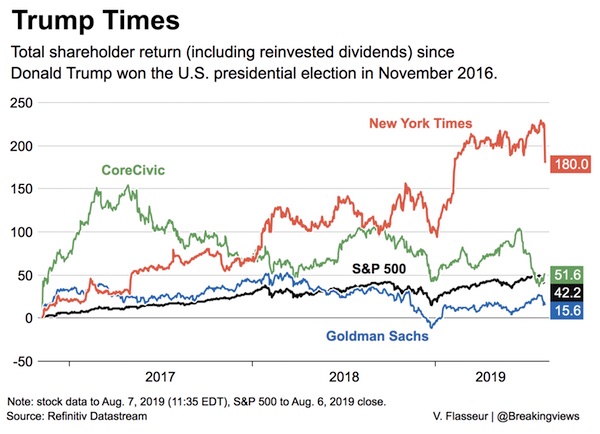
Steffano Webb Vacuum Cleaning Co. machine, Christchurch, New Zealand 1910
When I had some serious problems with my Mac earlier this year, I wrote that I saw no other alternative then to get a new one. Several readers, for different reasons, commented that Macs are not the way to go. Of course, I’ve heard much of that many times before, and I haven’t for a moment been tempted to switch away from Mac. I’ve seen many people go the opposite way, though, from Windows to Mac.
One commenter, who goes by the moniker AutoMan, had a slightly different take, and one I found interesting. He talked about the proper attitude towards computing in the face of The Automatic Earth’s own “principles”, like those of getting and staying out of debt, and teaching yourself skills, for instance. So I asked Automan to wrote a guest post on the topic, and here it is. Please note I’m not a tech guy, so, as an editor, it’s hard for me to assess much of what AutoMan writes, but I’m sure many people will be able to take away quite a bit from this post. And I’ll be the first to admit it would be better to have more control over the whole process of using a computer or related device.



AutoMan: Recently, Raúl Ilargi Meijer – editor-in-chief of The Automatic Earth (TAE) – tried to awaken his Mac, something he had done countless times before, and faced the terror that computer users dread the world over: a cold dead machine. You can just hear him shout, "Damn!!! #$%@!" His trusted Mac – no ordinary machine, mind you, but a shiny icon that radiated "cool" and had faithfully served Ilargi through thick and thin – was no more.
Ilargi quickly gave notice to TAE’s faithful readers of his misfortune ("Mac died"), noting he had “no choice but to try and get a new one tomorrow, and that’s the last thing we need here at TAE these days, major expenses.” A number of TAE’s readers (including yours truly), however, perhaps not fully appreciating just how cool Ilargi’s Mac really was, questioned whether a Mac was really the most suitable machine for TAE, in light of the principles espoused by TAE. In response, Ilargi did not react defensively, like a lesser man might; instead, Ilargi, demonstrating character, despite his misfortune, graciously invited me to submit a guest post. Here it is.
This post will not seek to preach about any particular computer platform–indeed, it is possible that a replacement Mac is the best choice for Ilargi’s work at TAE at this time–instead, this post will seek to provide you, dear reader, with a set of lenses regarding how to analyze your tech decisions to adapt your computer technology in preparation for the post-collapse world that TAE is warning us about.

TAE Principles relevant to Technology
To begin with, readers of TAE know that TAE seeks to prepare us for a deflationary crisis. Nicole Foss reiterated this point in "The Future Belongs To the Adaptable":
"As our readers know, we do not provide investment advice. We do not exist to help people make money in the markets, but to help them avoid losing what they have in a deflationary crisis, at a time when almost everyone will lose a great deal."
TAE has published a list of principles to help its readers prepare for the deflationary crisis (a recent version of the complete list appears in "How to Build a Lifeboat"). Out of the nine principles that TAE espouses, there are four principles that are directly relevant to our technological choices, namely:
1) Hold no debt (for most people, this means renting);
5) Gain some control over the necessities of your own existence;
6) Work with others to enhance personal and community resilience and security;
8) Be worth more to your employer than he is paying you.
Before applying these principles to technology, it is necessary to briefly survey the current landscape of consumer computing, the world from which Ilargi’s Mac arose.

The current tech world: Microsoft, Apple, Google, and FOSS
For our purposes, the current consumer computing world can be divided into the following four competitive fields (or "spaces"): (1) desktop (including laptops), (2) server, (3) mobile (including smartphones and tablets), and (4) the burgeoning "DIY electronics movement" ("DIY" refers to "Do It Yourself"). These fields are dominated by the following "players": the Microsoft Corporation, Apple Inc., Google Inc., and "Free and open-source software" ("FOSS"). (Amazon, Facebook, and other players are also significant, but for the sake of brevity, we’ll narrow our focus to these four primary players.)
The first three players are all major corporations; indeed, the three are some of the most profitable corporations in the world. The last player, FOSS, is different: it refers to the myriad of software projects that are produced under a FOSS license and are available free of charge, including operating systems, such as Linux, and the descendants of the original Berkeley Software Distribution, e.g., FreeBSD, NetBSD, and OpenBSD.
FOSS actually has two branches: "free software," a term coined by the father of free software, Richard Stallman, which stresses the political value of the freedoms secured by FOSS licenses, and "open source," a term which stresses the pragmatic advantages of having access to the source code. In practice, the two approaches espouse the same freedoms, and FOSS licenses generally secure the right of users to (1) run the code for any purpose; (2) modify the code; and (3) distribute the code without paying royalties to the original producer (as David A. Wheeler summarized in "Why Open Source Software / Free Software?"). The formal definitions of Free Software and Open Source can be found here and here, respectively.
What is perhaps more important than the license terms is the system of production that arises from these licenses. Harvard Law School professor Yochai Benkler coined the term "commons-based peer-production," in his seminal paper "Coase’s Penguin, or Linux and the Nature of the Firm," Professor Benkler posited that "commons-based peer-production" is a different type of system of production, which is markedly different from the traditional firm-based and market-based systems of production; perhaps most notably, it is not based on the profit motive, although it is not necessarily antithetical to the profit motive, either. Aaron Krowne of Free Software Magazine has offered a broader definition, as follows:
"commons-based peer production refers to any coordinated, (chiefly) internet-based effort whereby volunteers contribute project components, and there exists some process to combine them to produce a unified intellectual work. CBPP covers many different types of intellectual output, from software to libraries of quantitative data to human-readable documents (manuals, books, encyclopedias, reviews, blogs, periodicals, and more)."
With this background, we can now turn to the playing field from which Ilargi’s late Mac arose: the desktop space, which will be our primary focus.

The Desktop

Microsoft
The desktop space is overwhelmingly dominated by Microsoft: its windows operating system, in its various incarnations (Windows XP, Vista, 7, and 8) runs on upwards of 90% of desktop computers (including laptops) (according to Net Applications, a web analytics firm). Even if you don’t run Windows, Microsoft’s overwhelming market share may be relevant to your computing choices, since it may affect the work product you must work with (e.g., file formats, such as Word, Excel, PowerPoint, etc.) and the technology at your workplace and among co-workers and colleagues. Further, Microsoft’s overwhelming market share in the desktop space also means that most desktop programs have a Windows version, and many programs have Windows versions exclusively. An understanding of how Microsoft captured the desktop space may give us some useful insights.
Because IBM was late to enter the personal computing space, in order to play catch up (including with Apple, which had beat it to the personal computer market), its engineers used off-the-shelf hardware to get its original PC models to market. This made it easy for other manufacturers, such as Compaq, to create clones of the IBM PC by purchasing the same off-the-shelf hardware and then reverse engineering the BIOS of IBM’s PC (the Basic Input/Output System; the small firmware that initializes a computer). Although IBM effectively created the PC industry with its preeminent brand name at the time, as the dominant large computer manufacturer, it lost the PC market to the clone manufacturers: Dell, Compaq, HP, ACER, Lenovo (which later bought its ThinkPad line), etc.
Microsoft, however, made out like a bandit because its deal with IBM permitted it to sell its operating system to the other clone manufactures, who produce a never-ending variety of new PC models, around the world. That’s the secret of how Bill Gates & Co. built the "House of Microsoft": on the back of IBM’s cloned hardware. In a sense, Microsoft’s overwhelming market share on the desktop is the fortuitous product of a de facto commons-based peer production, carried out not by volunteers but by the clone manufacturers, a de facto commons-based peer production that was the result not of IBM’s generosity in sharing its hardware designs but its inability to control its hardware design (due to its late entry into the market).
Microsoft’s dominant position in the desktop has allowed it to nurture its second cash cow on the desktop: Microsoft Office (its office suite of desktop applications, e.g., word processing, spreadsheet, presentation software, email, database, etc.). Although Google has actively promoted a cloud based competitor, Google Docs, and respectable FOSS alternatives exist, e.g., Apache OpenOffice and LibreOffice, Microsoft Office overwhelmingly dominates the desktop office suite market, with estimates of upwards of 80% of the market. In fact, over the last few years, Microsoft Office’s share of this market has actually increased.

OS X
Apple’s OS X (the operating system produced by Apple that Macs run natively, such as on Ilargi’s late Mac) comes in a very distant second in the desktop space, running on about 7.53% of desktop computers (according to Net Applications). Apple, however, focuses on providing high-end machines that sell at a premium to regular PC hardware (the least expensive Mac laptop, the 11-inch MacBook Air, currently starts at $999 in the U.S., and to purchase a MacBook with a discrete graphics card will set you back $2,599.00).
Mac aficionados claim that the higher prices are offset by lower maintenance costs. Because Apple sells both the hardware and the operating system software, it purportedly is able to provide a more integrated system (or so it claims). Apple is also known to take great pains to maximize the design esthetics of its machines and user experience, compared to Microsoft, which is known to focus more on adding as many features as possible.
Be that as it may, Macs tend to dominate niche segments of the desktop space, such as fields that rely on audio-visual software and the education field; paradoxically, Macs tend to be most popular with the least computer savvy (who rely on their perceived ease of operation, including perceived lack of malware), as well as the most tech savvy, such as Silicon Valley engineers, who covet the avant-garde hardware and the Unix features of the operating system (or is it due to the "cool factor" fostered by Steve Jobs that increases their perceived personal attractiveness as they click away at Starbucks?).
Recently, Apple has been making considerable strides in breaking into the corporate market: many business users are replacing PCs with Apple iPads, and others are moving up the Apple lineup, e.g., from iPhones to Macs, according to the Wall Street Journal ("Apple Devices Flow Into Corporate World,", January 9 2014).
One idiosyncrasy of OS X is that it is a hybrid proprietary-FOSS operating system. OS X’s core, i.e. the foundation of the system, known as Darwin, is licensed under the Apple Public Source License, which is approved as a free software license by the Free Software Foundation. In fact, Apple incorporates a number of FOSS components into OS X and openly praises commons-based peer production:
"Apple believes that using Open Source methodology makes Mac OS X a more robust, secure operating system, as its core components have been subjected to the crucible of peer review for decades. Any problems found with this software can be immediately identified and fixed by Apple and the Open Source community."
Other parts of the system that wrap around this core such as the graphical users interface, however, are proprietary to Apple. Apparently, Steve Jobs, the master marketer, decided to harness the force of commons-based peer production and to simply add a veneer around that core; hence, through this veneer, Apple is able to effectively monetize FOSS software. The question for users is whether the veneer is worth Apple’s asking price.

FOSS: Linux & Co.
The main FOSS contender in this space, the Linux operating system, only runs on about 1.73% of desktop computers, in its various distributions (e.g., Ubuntu, Debian, Red Hat, etc.) (according to Net Applications). The Linux operating system was originally developed by Linus Torvalds (its namesake), a software engineer from Finland, who put out a call for help on the internet, in 1991, for fellow techies from around the world to lend a hand in developing a free operating system ("Do you pine for the nice days of minix-1.1, when men were men and wrote their own device drivers?" Linus Torvalds).
Through his call, Torvalds unleashed the power of commons-based peer production, which resulted in one of the most successful FOSS projects of all time: the Linux operating system. This was made possible not only by the commons-based peer production that answered Torvalds call to arms, but also by the legacy commons-based peer production code that already existed at the time, thanks primarily to the work of Richard Stallman and his GNU Project, which had already completed the work on many of the core features of an operating system, leaving Torvalds and his legions to focus on the heart of the operating system: the kernel (to this day Stallman insists that Linux should be referred to as "GNU/Linux" for this reason).
Torvalds is pragmatic to a fault: he owns a MacBook Air, for the utility of the hardware, but runs only Linux as its operating system, scrapping the native OS X. In contrast to the pragmatic Torvalds, Richard Stallman is an unyielding idealist, eschewing even many popular Linux distributions as being compromised by the inclusion of certain commercial features. As for Apple, Stallman has called for a boycott of its products altogether, for a litany of reasons.
Don’t let Linux’s small market share on the desktop fool you, Linux is a giant in computing overall. It runs on over 90% of supercomputers. Hollywood purportedly uses Linux on over 90% of its desktops and servers for the creation of special effects and animation. One would expect to find a state of the art commercial platform in the bastion of capitalism, the New York Stock Exchange (NYSE), but no: The NYSE runs Linux, because its messaging system is apparently superior to the commercial systems. The scientific community is known to be one of Linux’s niches, building on its Unix background. The International Space Station, for example, recently replaced Windows with Linux for its laptops. According to ComputerWeekly.com (“International Space Station adopts Debian Linux, drops Windows & Red Hat into airlock”, May 13, 2013), the Manager of the Space Operations Computing (SpOC) for NASA Keith Chuvala explained their decision:
"We migrated key functions from Windows to Linux because we needed an operating system that was stable and reliable — one that would give us in-house control. So if we needed to patch, adjust, or adapt, we could."
Perhaps even more importantly, Linux is also a giant in the mobile space, thanks to Google’s adaption of Linux for its Android mobile operating system. In addition to using Linux in the servers that bring you the Google search engine, incorporating Linux into Android, Google also created a Linux-based desktop operating system, known as Chrome OS, which is included with its new line of laptops, known as Chromebooks.

Google Chromebook
Recently, Google launched an attack into the desktop space with its Chromebook line of computers, which have become best-sellers almost overnight. Chromebooks are ultra-affordable laptops (they currently start at $199) and run a minimalist operating system that runs all apps out of a browser, known as Chrome OS, a Linux-based operating system. But that hasn’t stopped some enterprising techies from purchasing Chromebooks and loading regular versions of Linux on them; thereby, converting them into full Linux computers, albeit with bare-bones power (but for $199 and all the free software you can use, who can beat that?).

Servers
Servers are the dedicated computers that provide a variety of "services" to a network; they come in all types: email servers, file servers, print servers, web servers, etc. Microsoft and FOSS operating systems, such as Linux and the BSD derivatives, tend to share this space as major players, with Microsoft appearing to take the lion’s share. Linux, however, is known the world over as an excellent operating system for servers, and may be significantly undercounted in the relevant surveys.

Mobile
Although our focus is primarily on the desktop, we must take note that the mobile space is effectively disrupting the desktop. Ever since Steve Jobs introduced the iPhone in 2007, the computing world has been subjected to tsunami of mobile devices that have changed the desktop space to its core. Increasing number of users, for example, are eschewing laptops altogether in favor of tablets.
The mobile space is dominated by Apple and Google Android, with Android taking the lion’s share, but Apple is reportedly taking the lion’s share of profits. Android is based on the Linux kernel. Google distributes Android free of charge to manufacturers, in exchange for compliance with certain terms.
Microsoft has a tiny share of the mobile space: both its smartphones and tablets have tiny shares of their respective segments. Microsoft’s attempt to leverage its desktop operating system to persuade users to adopt tablets running Windows 8 appears to have failed for the time being. When the consumer computing market is viewed as an aggregate of the desktop and mobile segments, Microsoft’s share of the overall market has reportedly dropped precipitously. From 2004 to 2012, Microsoft’s share of the consumer computing market dropped from 95% to 20%, according to IDC.

The DIY electronics movement
We must also take notice of the burgeoning DIY electronics movement. This movement seeks to expand personal electronics from the domain of personal computers to all facets of day to day living. It makes use of off-the-shelf electronic parts to create all types of projects: robots, sensors, works of art, wearable electronics–and gadgets of all types. FOSS is at the heart of this movement: from providing the main operating system for the tiny computers that provide the brains for its projects, to the common specifications for much of its electronic gear.
Anyone looking for the "Bill Gates" or "Steve Jobs" of the DIY electronics movement should look no further than Limor "Ladyada" Fried, a young MIT-educated entrepreneur who founded Adafruit, a New York City based distributor of all things DIY electronics (see a recent interview). Ladyada, who often sports a bright purple hairdo and lip ring, was named Entrepreneur of the year by Entrepreneur magazine in its January 2013 edition. She was also the first female engineer to appear on the cover of WIRED magazine. Both she and her company act as evangelists for the DIY electronics movement. Check out her weekly Youtube show, Adafruit learning system, tutorials, and blog.
The Raspberry Pi, a tiny single-board computer (about the size of a credit card) is an example of the type of hardware that makes up the arsenal of the DIY electronics movement. This tiny computer was originally intended to educate youth on computer hardware (given the trend away from users dabbling with the innards of computer systems), but was quickly adopted by hobbyists who use it as a workhorse computer for their projects. It currently has two models: model A, which sells for $25 (US), and model B, which sells for $35 (US). The Raspberry Pi doesn’t do Windows or OS X (which even if it were adopted to run on this hardware, perhaps in its iOS incarnation, would violate Apple’s licensing terms). Linux is its chosen operating system.
Likewise, the arduino is an inexpensive single-board microcontroller, distributed under a FOSS license, which costs approximately $30 for an official version and $9 for a clone. Arduinos are used in a myriad of DIY electronics projects.
In theory, the DIY electronics movement may also offer ordinary people a chance to compete in the coming tsunami of the automation of jobs, resulting from the application of robotics and computer automation to the workplace. "One recent study by academics at Oxford University suggests that 47% of todays jobs could be automated in the next two decades," according to The Economist ("Coming to an office near you," January 18, 2014). By mastering DIY electronics, it is possible that some people will be able to use the available off-the-shelf technology to supply services to this insatiable demand for automation, since the DIY electronics technology is by and large based on FOSS and available to anyone who is willing to pay the price of learning.

Four Tech-Specific Principles
The technology reviewed above arose in an environment of cheap credit and cheap energy, which forms our current tech-world. Applying TAE’s four tech relevant principles to the consumer-computing world that we just surveyed, I arrive at the following:
1) To avoid holding debt, scrutinize all tech purchases under the light of the post-collapse reality;
2) To gain some control over the necessities of your own existence, gain as much control over your personal technology as possible, including by adapting FOSS and DIY solutions where possible;
3) Learn the art of working with others in FOSS and projects, both by contributing to existing projects and eventually–for some–starting your own FOSS projects;
4) To make yourself more valuable to your employer, learn cost-effective technical solutions that apply in your occupation.
Let’s look at the first principle in detail.

1) To avoid holding debt, scrutinize all tech purchases under the light of the post-collapse reality
Will you be whipping out that credit card to buy that shiny new Mac? If so, you may be violating TAE’s first principle of holding no debt.
In a post-collapse world that is suffering a deflationary crisis, cash and credit will be very hard to come by. Nicole Foss, for example, has warned that ordinary people may not have access to any credit, at all. Just imagine what that will mean in an economy such as the U.S. economy in which consumers habitually buy almost all purchases of any size on credit. Moreover, holding debt in such an environment will be extremely detrimental because it will be very difficult to service any debt. Hence, avoiding debt is TAE’s suggested top priority. From a planning perspective, holding no debt means not only avoiding taking on debt now, while you prepare for a deflationary crisis, but also learning debt avoidance skills.
The principle of holding no debt shifts the "time is money equation." Under the precept that time is money, it is often more economical to spend money in exchange for saving time. This precept has become especially valuable in recent years, in which the demands on our time has exploded. However, in a world in which holding debt is anathema, this precept is turned on its head: suddenly it may be more economical for you to use more of your time in order to save that precious capital, given the scarcity of capital in the deflationary environment in which you must survive. For our purposes, we can refer to the deflationary version of this precept as "money is time," to remind ourselves of the new priority of saving money, even if it means using more of our time.
In the tech world, the normal "time is money" precept usually means buying a commercial solution, such as Windows or OS X, instead of a FOSS solution, because the commercial solutions usually have the "rough edges" worked out, while FOSS solutions often require you to roll-up your sleeves to fine-tune the particular application to your needs. That’s what often turns people off to FOSS solutions. They prefer, for example, to just turn on a Mac and have it just work. In a post-collapse world, however, that may not be possible. The money for that Mac may be needed to feed yourself and your family (even now, when you may not need that money for food, you may be better off saving that money, in preparation for the deflationary crisis, when you may need it for food).
So does this mean that everyone should immediately avoid buying Macs and Windows machines and opt for FOSS solutions? No, it does not. A reasonable approach to this problem is more complicated. For example, the software requirements of your field may make a FOSS solution not viable; competitive FOSS solutions may simply not be available. Likewise, you may have too much invested in a commercial solution, in terms of equipment and/or know-how, or both, so that a FOSS solution would be too expensive to implement, despite the low software and hardware costs. Consequently, what is needed is a more realistic approach to analyzing computer purchases in light of the deflationary threat. One approach (and this is by no means the only approach) is as follows.
First, if your purchase is a replacement for a machine you currently own, you should carefully scrutinize whether you really need a new machine, or whether you can repair or upgrade your current machine. This is a direct application of the "money is time" precept: you should seriously consider using your time to repair or upgrade your current machine (assuming you have those skills or can acquire those skills), in order to save your capital. Anyone who has spent time in a lesser-developed country and has observed how the people deal with the maintenance of machinery may have already witnessed the application of this precept. For example, if an automobile starter motor breaks down in the U.S., mechanics will often simply replace the whole starter, without even trying to repair it. In lessor-developed countries, on the other hand, mechanics will often go through great pains to open the starter and to try to repair the starter itself. This is because the cost of labor (the time) is much lower than in the developed country, and the replacement part may also be more expensive due to higher importing costs. Well, the forces of deflation may force a similar reality on developed countries; hence, learning such skills now, as well as the "try to repair attitude," may be an excellent investment.
In this regard, you may also consider installing a FOSS operating system in that older hardware. Operating systems, such as Linux, are known to work much better on older hardware than Windows or OS X. You may also consider using your old hardware for other purposes, e.g., file server, media server, firewall, etc.
Second, if you must buy a new machine, consider buying a tablet (e.g., iPad, Android, Kindle Fire, or Windows RT) instead of a laptop. For example, if you will be primarily using the device to consume content instead of producing it, a tablet may be an adequate solution. More and more people are opting for this option, so much so that it appears to be eating into the sales of desktops (including laptops).
Third, if you must buy a laptop or regular desktop, consider buying the minimum. You could first look at a Chromebook solution (with prices starting at $199 in the U.S.), and then consider a Linux solution, followed by a Windows machine, and finally, a Mac (given the generally higher up-front costs of Macs). The key is to learn to analyze your purchase decision in light of the benefits that you really need versus the cash that you must surrender, in light of the premium on the value of cash in a deflationary environment.
In this regard, if you are forced to run a considerable number of commercial apps that are optimized for Windows, you may conclude that a Windows solution may actually be the logical choice, i.e., it may permit you to purchase hardware that is cheaper than Apple’s offerings, while obtaining a machine that can run Windows software without having to incur the costs of dual booting a Mac (i.e., setting up a Mac to run both Windows and OS X separately) or running Windows in a virtual machine on a Mac, both of which sometimes require higher priced Macs to run efficiently. Of course, running Windows instead of a Unix operating system, such as OS X or Linux, may mean higher maintenance costs (e.g., for keeping the system free of malware). However, when "money is time," it may be worth investing the time to learn how to properly maintain that Windows machine, to avoid having to pay for higher prices hardware, even if you don’t really like Windows.
Fourth, you may seriously wish to consider adopting FOSS as your default solution for your tech needs, given the zero price of FOSS software (provided you invest the time in learning the necessary skills to implement FOSS solutions, of course, but remember the money is time precept). Note that in many FOSS operating systems, such as Debian Linux, the default set up provides a package management system, in which you can simply select software from the numerous offerings, "click on your selection," and the system automatically loads the selected software–free of charge. Of course, sometimes you must "open the hood" and configure the particular installation, but since "money is time," the learning costs may be worth it. Further, even if the software offerings are not as a good as commercial offerings, they may be good enough, especially in the economic reality in which you must survive. Hence, the question may no longer be what is the best, coolest solution–which may become an unaffordable luxury of bygone days; instead, the question may be what is the absolute cheapest solution that provides a good enough output.
However, FOSS can only be a "default," and not a definitive solution because it is possible that FOSS is not a viable solution for your particular situation, as noted above; it may even be a more expensive solution when all costs are factored in.
Fifth, if you determine that you cannot adopt FOSS as your operating system, you may have no choice but to learn to "dance with the guerilla." This means learning to use Windows or OS X while minimizing your "lock-in" to these systems and while maximizing your use of FOSS on these systems (to develop your FOSS skill set). Minimizing your lock-in means avoiding purchasing software for these systems for which there are FOSS alternatives. For example, you could decide to avoid Microsoft Outlook and opt for Mozilla Thunderbird, instead. Further, you could decide to dual boot a FOSS operating system with your commercial system or run FOSS in a virtual machine, in order to build up your FOSS skills and software inventory (provided that your hardware permits these solutions).
If you are running OS X, you may wish to opt for FOSS apps instead of commercial apps (see examples here, here, and here). The more tech savvy can explore OS X’s FOSS components, as part of the guerilla dancing. Likewise, if you load one of the package management systems for OS X, such as MacPorts or Fink, you can directly access a plethora of FOSS software for your Mac at the command line level. Whether any of it will be of use depends on your particular needs. Similar solutions also exist for Windows (such as Cygwin and Npackd).
The bottom line is that "dancing with the guerilla" is an art form. The key is to realize that protecting your interests may require that you not automatically fall for purchases that the operating system producers may have designed to get your money while providing limited value. In bygone days those purchases may have been no big deal, but not if youre facing a deflationary crisis.
Finally, you should also be aware that the possibility exists that the large tech players, like Microsoft and Apple, may slash their prices in the face of a deflationary tsunami. The problem, however, is that they are unlikely to slash their prices sufficiently in comparison to the price of FOSS software, especially, since they are saddled with significant fixed costs that they may not be able to shake quickly enough to permit them to slash their prices substantially. Nonetheless, this is an additional factor to include in your calculus.

Conclusion
Those who wish to prepare for a deflationary crisis should scrutinize their purchases, including their tech purchases, in light of the harsh realities that a deflationary collapse will impose. Seeing the beauty of solutions that work in such an environment will pay dividends in the brave new world.



This article addresses just one of the many issues discussed in Nicole Foss’ new video presentation, Facing the Future, co-presented with Laurence Boomert and available from the Automatic Earth Store. Get your copy now, be much better prepared for 2014, and support The Automatic Earth in the process!































